

Extreme Turbulence (ET) Probe
Introduction The danger and cost of hurricanes
continue to be demonstrated with each hurricane season. Both the
intensification and eventual decline of these storms are largely
determined by turbulent exchanges of heat, water vapor, and momentum
between the atmosphere and the underlying surface. Scientists are
therefore keenly interested in obtaining direct turbulence
measurements within hurricanes. Standard turbulence sensors, however,
are not designed to withstand the extreme winds, rain, and spray
associated with these storms. The Field Research Division has
developed and deployed a new type of turbulence sensor that is
designed for hurricane environments. This sensor, referred to as the
Extreme Turbulence (ET) probe, can make accurate measurements in very
high winds (and rain) without being damaged.
The ET Probe is an innovative sensor intended for deployment on a
stationary tower or buoy, but it is based on the same technology used
in aircraft gust probes, including the NOAA Air Resources Laboratory's
Best Aircraft Turbulence (BAT) probe. Aircraft gust probes are
routinely operated at airspeeds exceeding 50 m s-1, so
this technology is fully capable of withstanding hurricane-force
winds. Unlike aircraft probes, the ET probe must be omnidirectional so
that it can respond to winds coming from any compass direction. In
addition, aircraft with gust probes tend to avoid precipitation,
whereas the ET probe is specially adapted to function in heavy
precipitation.
During early testing in 2003 and 2004, the probes were deployed near
the coast as hurricanes made landfall. A special strengthened tower
was used for these deployments, which lasted just a few days. These
deployments were primarily intended to be proof-of-concept
demonstrations for the probes. Since 2009, the probes have been
deployed for longer periods on fixed platforms over the sea. These
recent deployments are designed to provide observations of air-sea
turbulent exchange in high-wind conditions.
|  |
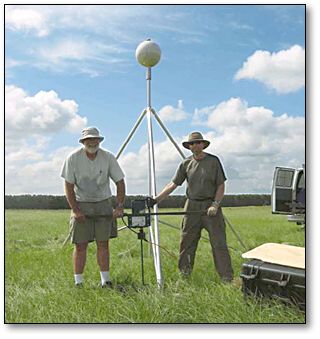
Tom Strong (left) and Rick Eckman setting a ground anchor
for an ET Probe deployed in advance of Hurricane Ivan in
2004. At this time the probes had no remote communication,
so the data were retrieved after the storm passed.
|
Project Objectives
The ET Probe project has the following objectives.
- Design, build, and test ET probes suitable for
deployment in extreme hurricane conditions.
- Deploy the ET probes on fixed over-water platforms where they
have a reasonable chance of measuring air-sea exchange in
hurricanes.
- Add motion-sensing equipment necessary for deploying the
probes on buoys.
- Collaborate with other scientists in deploying the ET
probe in other high-wind conditions.
Early development work on the probes was supported by both the
Office of Naval Research CBLAST program and by the USWRP Hurricane
Landfall initiative. This initial effort completed objective 1. Since 2009
ARL has received a limited amount of funding to address objective 2.
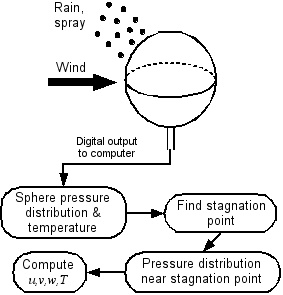
Concept of Operation
The figure at right presents the basic ET probe concept. The probe is
designed around a spherical shell that has a series of ports (holes)
distributed over its surface. Pressure sensors are attached to these
ports. Wind striking the sphere produces variations in the pressure
distribution over the sphere, with the peak pressure at the flow
stagnation point along the direction the wind is coming from. The
probe also contains two temperature sensors. The pressure and
temperature data are digitized within the sphere and then transmitted
to a small, single-board computer.
A data acquisition program on the computer searches the pressure data
taken along the sphere's equator until it finds the port where the
pressure is highest. This port is closest to the stagnation point. The
pressure distribution near the stagnation point is then used to
compute the magnitude and direction of the ambient wind
vector. Lastly, the program saves the three-component wind vector
(u,v,w) and the temperatures at 50 Hz.
Since the probe is designed to operate in hurricanes, a technique must
be developed to keep the pressure ports from being plugged by rain or
spray. During early development we investigated two techniques: a "passive"
technique that uses enlarged pressure ports and gravity drainage to keep the
ports free and an "active" technique that uses an air pump to backflush the ports.
The passive approach worked successfully both in testing and actual hurricane
deployments and has been generally adopted.
Probe Design
|
The ET probe is based on a 43 cm fiberglass sphere with three rows of
pressure ports, one row along the sphere's "equator" and the other two
18º above and below the equator. Within each row the ports are
spaced 36º apart, so there are 10 ports total in each row. A
fast-response temperature sensor is in a housing on top of the
sphere. During longer deployments sea birds were found to cause
problems by perching on the temperature housing. Bird spikes were
therefore added at the top of the probes.
All the probes now use the passive technique to keep rain from fouling
the ports. These are called big-hole probes, because they use ports
that are 6.4 mm in diameter instead of the 1.6 mm ports used with the
early ET prototypes. The large ports are connected to tubes that slope
upward to the top of the sphere. The combination of large holes and
gravity drainage is surprisingly effective in keeping the ports clear
of water. This design also has the advantage that no additional power
is required for the rain defense.
In the latest generation of the probe design, all the analog
temperature and pressure channels are digitized at 50 Hz by a small
data acquisition board inside the sphere. Low-pass filters are used to
eliminate aliasing before the channels are digitized. The digitized
data are sent via a serial line to a single-board computer running the
Linux operating system. This computer is located in a separate housing
both for easy access and to improve the odds of data recovery if the
probe itself is lost in a storm. Raw pressure and temperature data
coming from the probe are used by the computer to generate the 50 Hz
wind vector measurements.
In the 2010 deployments, the probes included cell-phone modems that
allowed remote two-way communication. The bandwidth was sufficient to
issue remote commands to the computer and to download time-average
statistics, but not for transferring any 50 Hz data files. A satellite
modem could also be used at more remote locations.
|
 |
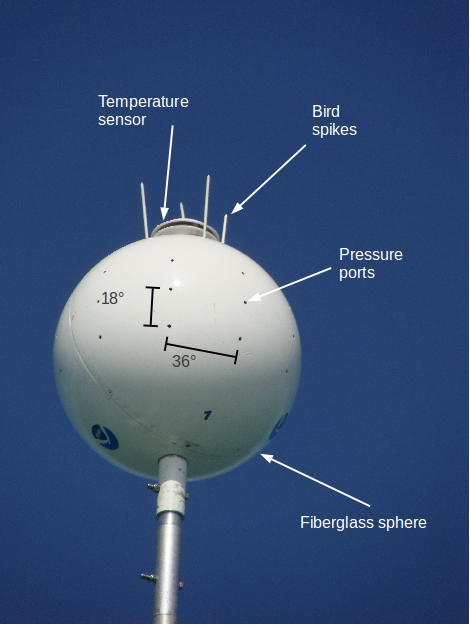
External design of the ET probe. The
temperature sensor is in a housing on top
of the probe. Bird spikes are a recent
addition due to the large number of sea
birds at the deployment sites.
|
Deployments
|
As noted above, the early ET probe deployments took place along the
coast as hurricanes made landfall. In September 2004 two probes were
deployed along the Gulf coast near the Florida-Alabama border for
Hurricane Ivan. The hurricane's right eyewall passed near the
probes. The figure to the right shows the turbulent kinetic energy
(TKE) during Ivan's landfall for a thirty-hour period starting at 1200
UTC on 15 September 2004. The TKE at the peak of the storm was about a
factor of ten larger than the more normal values before and after the
storm. In many hurricanes it is actually the turbulent gusts rather
than the sustained winds that are responsible for much of the property
damage, so data like this are of great importance.
Since 2009 the probes have been deployed on over-water platforms for
months at a time during the hurricane season. The photo below shows a
probe deployed on the Tennessee Reef navigation light in the Florida
Keys. Platforms such as this are useful because they allow for
over-water flux measurements but can still be accessed by relatively
small boats. The long-term deployments have introduced a new set of
challenges that were not encountered during the earlier coastal
deployments. These include providing continuous power, including a
means of communication, accounting for heat buildup in the
electronics, and keeping birds from making a mess of the probes by
perching on them. ARL has come up with solutions to these
challenges. Both the 2009 and 2010 hurricane seasons resulted in few
tropical cyclones near the U.S., so the long-term deployments have not
yet resulted in a hurricane strike.
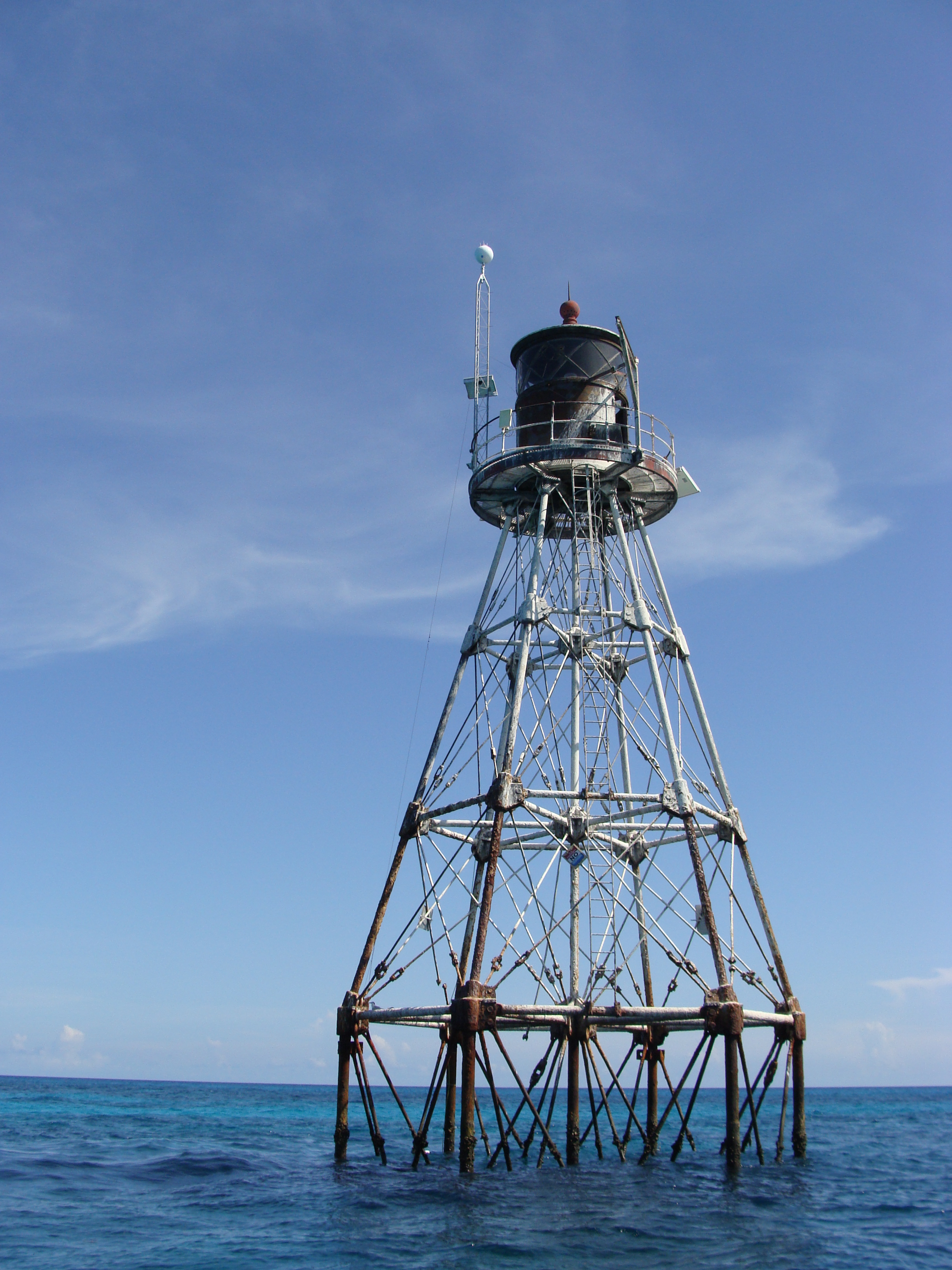
ET probe deployed on the Tennessee Reef
navigation light in the Florida Keys. The
white probe sphere is visible on the tower to
the left of the light enclosure.
|
 |
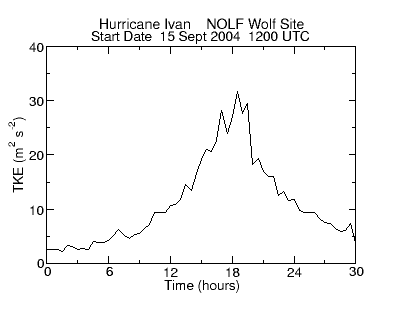
Turbulent kinetic energy observed by
ET probe during Hurricane Ivan.
|
Publications
- Dobosy, R. J., T. L. Crawford, D. L. Auble, G. H. Crescenti,
and R. C. Johnson, 2001: The extreme turbulence (ET) probe for
measuring boundary-layer turbulence during hurricane-force
winds. Preprint, Eleventh Symposium on Meteorological
Observations and Instrumentation, Albuquerque, NM,
Jan. 14-19, Amer. Meteor. Soc., 50-54. [View / download
PDF]
- Eckman, R. M., R. J. Dobosy, T. Strong, and D. L. Auble,
2004: Development and initial deployment of an omnidirectional
pressure-sphere anemometer for observing winds and turbulence
in tropical cyclones. Extended Abstract, 26th Conference on
Hurricanes and Tropical Meteorology, Miami, FL, American
Meteorological Society, 368-369. [View / download PDF]
- Eckman, R. M., R. J. Dobosy, T. W. Strong, and P. G. Hall,
2006: In-situ measurements of 3D turbulence in Hurricanes
Frances and Ivan using a pressure-sphere anemometer.
Extended Abstract, 27th Conference on Hurricanes
and Tropical Meteorology, Monterey, CA, American
Meteorological Society, paper 10C.4. [View / download PDF]
- Eckman, R. M., R. J. Dobosy, D. L. Auble, T. W. Strong,
T. L. Crawford, 2007: A pressure-sphere anemometer for
measuring turbulence and fluxes in hurricanes.
J. Atmos. Ocean. Technol., 24 ,
994-1007.
|





